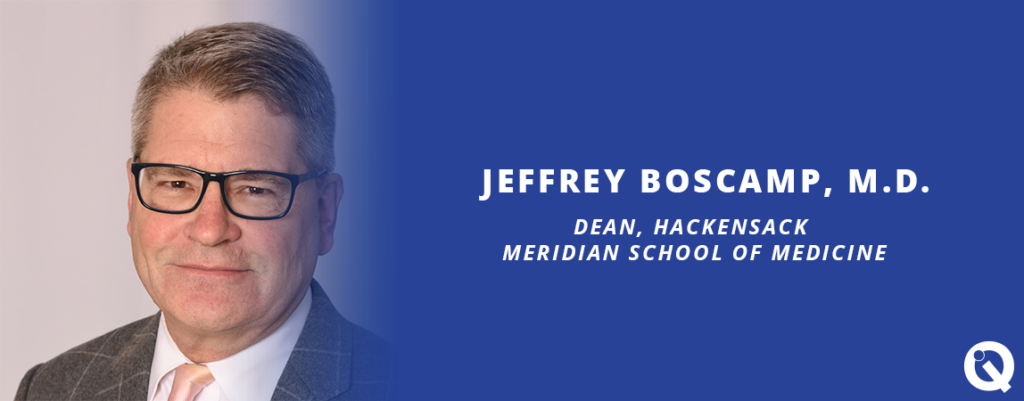Jeffrey Boscamp, M.D., is Dean of the Hackensack Meridian School of Medicine, a member of the Quality Institute’s Education Council, Institutes of Higher Learning.
Your medical school vision states that every person in New Jersey, and in the United States, regardless of race or socioeconomic status, will enjoy the highest levels of wellness in an economically and behaviorally sustainable fashion. How can a medical school drive that kind of systemic and ambitious change?
Starting a new medical school isn’t for the faint of heart. You must have a good reason. And for us the vision is to create a new and different next generation of physician — a monumental goal, but the only way that you can really change our health system. The discussion started with Bob Garrett (Hackensack Meridian Health CEO) saying, “How can we make a big impact on health care in the country?” It began with the realization from all of us that to change the health care system that spends this much money — and doesn’t get the outcomes it should — you need to start earlier in the process with a new type of student and a new way of teaching.
Central to the curriculum is something you call the Human Dimension. The aim is for students to understand the role of community in health and wellbeing. How do you accomplish that?
This longitudinal course starts on the very first day of school and is framed around social determinants of health. Students are matched up with a medically and socio-economically challenged family and immersed in that family’s home through regular visits and time in the community. The students see and experience those challenges…Imagine you’re in an ambulatory clinic and somebody’s diagnosed with type two diabetes. You tell them to exercise and eat better. But if you’re not out there in the community and don’t realize it’s a food dessert with no green vegetables or safe places to exercise then you really don’t understand the patient and their health. … Our students are going to town board and community meetings. One student contacted the mayor of Paterson to get a change in the bus route so patients at one housing area could get to the hospital for appointments.
You were founded in 2015. What are the benefits and challenges of being a new medical school?
The opportunity of a new school is you can have a mission and a vision and have a once-in-a-lifetime opportunity for everything to be intentional. You can design and execute and create curriculum reform without people saying, “But that’s not the way we’ve always done it.” When you’re new, you can attract students and faculty who know what you want to do. You get total buy-in.
But it’s a blank slate and you must build from nothing. We’re teaching an innovative curriculum and you hold your breath and say, “I wonder about tests scores since we are doing things so differently.” A gratifying moment came when we saw that our students’ test (United States Medical Licensing Exams) scores were fantastic. This year we had 6500 applicants for 165 positions.
You had the opportunity to design your physical plant from the ground up. What were you able to achieve through that process?
Medical knowledge is exploding. People say half of what you learn in medical school could be outdated in five years. It doesn’t make sense to just feed students knowledge in large lecture halls. The whole point is to get students to teach each other … to think critically and problem solve. From the standpoint of the physical plant, we’re sitting on what was the headquarters of Hoffmann-LaRoche. A great infrastructure. We hired architects specializing in medical schools and said, “We don’t want four lecture halls because that’s not what we do. We need a ton of small group rooms so that students can sit with preceptors.” We said, “Here’s our curriculum. Build us the spaces we need.”
Finally, we like to ask our interviewees a question beyond their professional lives. So can you tell us your favorite New Jersey artist (singer, writer, director, etc.).
The actor and director, Alan Alda, even though I know he was born in the Bronx. But he lived most of his life in New Jersey. He played Hawkeye Pierce, a surgeon on MASH and he inspired me to become a doctor. Later in his life he took up the art of communicating science to the public. Given the flood of misinformation and disrespect of science, that’s more important than ever. Here’s a tidbit. During the filming of MASH, he commuted every week from Leonia to California to keep his family in New Jersey.

